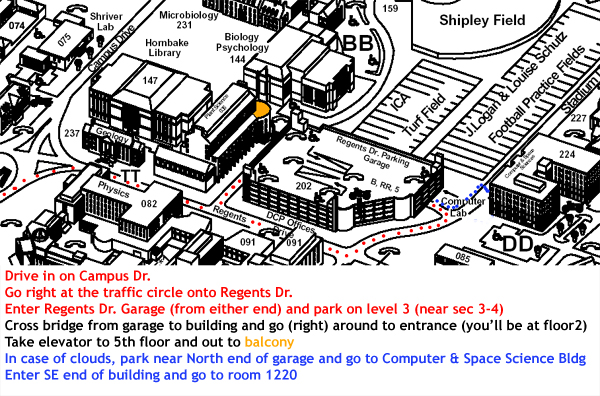Venus Transit 2004!
The UMD Astronomy Observatory Remains Closed
Fall 2024 Update: The UMD Astronomy Observatory remains closed to all public outreach activities.
[Ooops, please take me to the page about 2012 Transit of Venus!]
Witness the first Transit of Venus in 122 years
Join the Department of Astronomy
Tuesday, June 8 2004
from 5:30 - 7:30 AM
5th Floor Balcony, Plant Sciences Building
- Park (free) on Level 3 in the Regent's Drive Parking Garage (entrance on Stadium Dr.).
- Walk across the bridge (near section 3-4) in the southwestern corner of the garage.
- Enter the building and take the elevator (you will be on the 2nd floor) to the 5th floor.
- Walk out onto the balcony.
In case of cloudy weather, join us in the Computer and Space Science Building (on Stadium Drive), in the Computer Lab, Room 1220. We will view the transit using the computers.

Venus Transits: A Historical Perspective
compiled by Grace Deming
First Observations:
It has been almost 122 years since the last transit of Venus occurred in 1882. The June 8 Venus transit is an exciting observational event that will be shared by skywatchers all over the globe thanks to modern technology. However, relatively few individuals witnessed past transits, since a properly equipped telescope is necessary to view the event. After the invention of the astronomical telescope in 1609, the means to observe the next transit became available. Although Johannes Kepler predicted a Venus transit would occur in 1631, the event was not visible from England. Jeremiah Horrocks, an Englishman, predicted and then observed the next Venus transit on Nov. 24, 1639.
Astronomical Significance:
In 1691, Sir Edmond Halley (of Halley's comet fame) proposed that transits could be used to calculate the distance between the Sun and the Earth and also the Venus-Earth distance. Observations of the transit made at widely space locations on Earth would show slightly different paths crossing the Sun. By recording the path, timing the transit, and using trigonometry, these important solar system distances could be determined accurately. Although measurements were made during 1761 transit, the 1769 transit was placed more optimally. Making the argument that a more accurate Earth-Sun distance would improve navigation methods, astronomers received support form King George III for an expedition to Tahiti. The success of this mission coupled with measurements taken from other sites enabled the Earth-Sun distance to be determined to within a few percent of the modern value. By the next transit in 1874, more than 60 expeditions were funded including 8 that were appropriated $177,000 by the U.S. Congress. Cloudy weather and observing difficulties did not yield an improvement in the Earth-Sun distance. But 8 years later, the astronomers' persistence paid off. The transit of Venus was visible from Washington, D.C. and Congress provided $85,000 to scientists. The transit of 1882, the last time a Venus transit occurred, gave a distance of 92,797,000 miles, only 59,700 miles in error. Today, distances to the Sun and solar system objects are measured using radar, which produces an accuracy of 30 meters (0.018 mile).
Future Transits:
The transit of 2004 will be used as an educational event to inform the public about this once-in-a-lifetime experience (hopefully twice since the next transit will be in 2012). Transits may again have a role to play in the detection of extrasolar planets-planets that orbit other stars. If an alignment occurs, it is possible that a planet in another solar system may come between its star and us. When this occurs astronomers would expect the star's light to diminish by a tiny amount. Currently, there are two such transiting planets that have been observed. They orbit stars similar to the Sun, HD 209458 and TR-56. The NASA Kepler mission has a planned launch date of 2007. This mission would monitor 100,000 stars over four years in hopes of detecting more extrasolar transits with 100 times the improved precision over ground-based measurements. In 2012 when Venus makes its next transit, astronomers hope to have found several additional transiting extrasolar planets.
Factual information taken from Astronomy magazine, June 2004.
Other Venus Transit programs in the region
- Black Hill Regional Park -- 5:15-7:30am: Ages 6-adult. Admission $5 or $4 for FOBH members. Eat breakfast & view Venus crossing the face of the rising sun. Special filters on volunteer operated scopes!
- Montgomery College, Takoma Park Campus -- 5:30 - 7:15am, Roof of the Parking Garage at Fenton and King Street, flier
Websites of interest
- Sun-Earth Day, all encompassing site -- history, activities, how to participate
- Transit of Venus has some neat applets for showing what is going on
- ESO
- F. Espenak
- Smithsonian Institution Libraries Exhibition Gallery
- Transit of Venus, history, activities
- UND Venus Transit Expedition, information, webcast